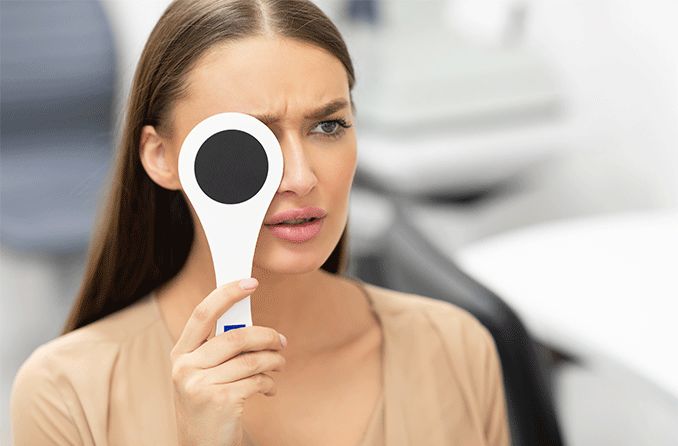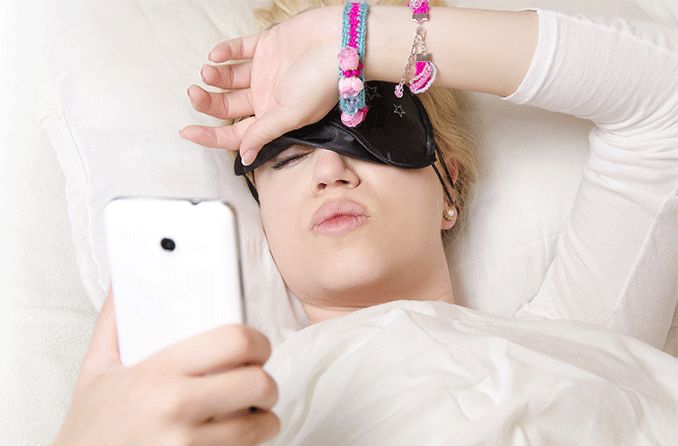What causes blurry vision in one eye?
Many different eye and health problems can cause blurriness in one eye. Conditions like cataracts and refractive errors are common, while more serious issues like eye strokes and acute glaucoma are somewhat rare.
Sudden blurry vision in one eye can be a sign of an emergency. Get medical help right away if this happens to you.
More common causes of blurred vision in one eye
Most common conditions that cause blurred vision in one eye can get better on their own or with treatment.
Some of their symptoms can be confused with another eye problem. If one eye looks blurry, an eye doctor can help you rule out more serious conditions.
Eye infection
Pink eye (conjunctivitis) is a common infection caused by viruses or bacteria.
While pink eye can make one eye blurry, you're more likely to have:
Red, burning or itchy eyes
Watery drainage (usually viral) or thick discharge (usually bacterial)
Talk to an eye doctor if your infection is giving you blurred vision in one eye (or both). It could mean you need to treat the problem with medicine.
Less commonly, a dangerous eye infection like infectious keratitis or endophthalmitis will cause one-sided blurriness. People may be at higher risk if they sleep in their contacts or don’t clean and store them properly. People who recently had eye surgery or who have certain health problems may also be at higher risk.
Call an eye doctor right away if your symptoms are severe.
READ MORE: Can COVID-19 cause blurry vision?
Refractive error
A refractive error is a problem with the way light focuses inside your eye. Common types include conditions like nearsightedness, farsightedness and astigmatism.
They cause fuzzy vision that can usually be corrected with prescription glasses or contact lenses. Around half of all Americans have at least one refractive error.
These conditions tend to cause blurry vision in both eyes, but sometimes they only make one eye blurry.
Anisometropia is when a refractive error makes your eyesight noticeably different in each eye. For example, you might feel like your left eye is blurry but your right eye is fine, or vice versa.
Anisometropia should be diagnosed and treated since it can lead to other eye problems.
Cataract
A cataract is a clouding of the natural lens inside your eye.
You might notice blurry, foggy or cloudy vision in one eye if:
You have cataracts in both eyes, but one eye is worse than the other.
You only have a cataract in one eye.
An eye doctor can perform cataract removal surgery to help you see better.
Corneal abrasion
A corneal abrasion is a scratch on your cornea, the clear layer at the front of your eye. Most scratches heal within a few days.
Some abrasions cause blurred vision in one eye. You might also notice:
Redness or swelling on your eyes or eyelids
Eye pain or discomfort
Talk to an eye doctor if your symptoms are severe or don't get better after 24 hours. Some scratches can lead to infections or other eye problems if they aren't treated.
Amblyopia
Amblyopia(sometimes referred to as "lazy eye") is when one eye is weaker than the other. It usually starts during childhood.
When a child's vision is blurry in one eye, their brain starts to ignore that eye. This makes the eye slip away from its normal position over time.
Children don't always recognize that one eye is blurry. Instead, you might see them:
Bumping into things
Squinting or closing one eye to focus
Tilting their head
Amblyopia can get worse if it isn't managed. Fortunately, it can be reversed when you start treatment early.
READ MORE: What to do when your child's new glasses make their vision blurry
Less common causes
Some conditions are less common than others.
Speak with an eye doctor about any changes in your eyesight. You may need to start treatment to prevent or slow down future vision problems.
Ocular (retinal) migraine
Ocular migraines, also called retinal migraines, can cause a blurry spot in one eye.
They can also cause temporary:
Twinkling or flashing lights in your vision
Total vision loss
These symptoms only happen in one eye. They usually go away between five minutes and an hour later.
An ocular migraine stems from your retina. It shouldn't be confused with a visual migraine aura, which stems from the brain.
A visual aura happens to the vision in both of your eyes. It is a group of eyesight sensations some people see before a migraine headache starts. You can have an aura without a headache, too.
READ MORE: What else causes blurry vision with a headache?
Diabetic retinopathy
Diabetic retinopathy is when blood sugar levels are elevated over time and damage the retina inside your eye.
It usually happens in both eyes at the same time, but some people with diabetic retinopathy may have:
Blurry vision in one eye only
Blurrier vision in one eye than the other
Controlling your blood sugar levels and scheduling routine diabetic eye exams can help lower your risk of retinopathy and other diabetes-related eye problems.
Macular degeneration
Age-related macular degeneration (AMD) is damage to the macula, which helps you see objects directly in front of you. It also allows you to see color and fine detail.
One possible symptom of AMD is blurred vision in your central field of view. It can also make straight lines look wavy and can lead to blind spots in your eyesight.
There are two types of this disease:
Dry AMD – Blurriness can happen in the intermediate or late stage. This type doesn't cause symptoms in the early stage.
Wet AMD – Blurriness can happen during the late stage (the only stage).
AMD symptoms sometimes start in one eye and then take a while to start in the other eye. Some people only have symptoms in one eye their entire lives.
Optic neuritis
Optic neuritis is inflammation in the nerve that connects each eye to the brain (optic nerve).
When it only affects one optic nerve, it can cause these symptoms in one eye:
Blurry vision
Dim or darkened vision
Washed-out colors
Eye pain that gets worse when you move your eye
Optic neuritis is commonly seen with neurological diseases like multiple sclerosis (MS), but it can happen for other reasons, too.
Tonic pupil
Sometimes, the small hole in the front of the eye (pupil) doesn't get bigger or smaller like it should.
Eye doctors call this Adie's tonic pupil or just tonic pupil. It's caused by a problem in the neurological system, not the eye itself.
It usually only happens to one pupil. This can cause symptoms like:
Blurred vision in one eye
Sensitivity to light
Difficulty reading
Emergency causes of sudden blurry vision in one eye
Sudden blurry vision in one eye (or both) could be a symptom of an urgent medical problem.
Talk to an eye doctor or get medical help if your blurred vision comes on quickly — even if it eventually goes away on its own.
Stroke or TIA
A stroke is when a blood vessel bursts or becomes blocked in the brain. Some strokes cause vision problems, including sudden blurry vision in one eye or both.
A transient ischemic attack (TIA), also known as a "mini-stroke" can cause the same symptoms. It's also an emergency.
The CDC recommends using "FAST" to check for problems:
F (Face) – One side of the face may droop when you smile.
A (Arms) – One arm may be lower when you raise both arms.
S (Speech) – Your speech may be slurred or unusual.
T (Time) – Every minute matters. Call 911 if you notice any of the first three signs.
Eye stroke
An eye stroke happens when an artery in your eye becomes blocked.
It usually causes sudden blurred vision or vision loss in one eye. This can affect part or all of your vision on that side.
Some eye strokes cause symptoms that last a matter of seconds or minutes. Others may be permanent. It's important to get medical help as soon as you can.
Acute angle-closure glaucoma
Acute angle-closure glaucoma happens when the drainage angle inside the eye becomes blocked. This causes a sudden increase in pressure inside your eye. It can lead to permanent vision loss, especially if it isn't treated quickly.
It may cause sudden blurred vision in one eye. Other symptoms can include:
Intense eye pain or headache on one side coming from the eye
Vision loss
Eye redness
Rainbow-colored halos around lights
Nausea and vomiting
Treatment for blurred vision in one eye
Your treatment will depend on what's causing the blurry vision.
Some conditions, like a mild case of pink eye or a minor corneal abrasion, may heal without treatment. Cataracts, on the other hand, can often be managed for months or years before you choose to have them treated. Other problems are time-sensitive and should be treated right away.
An eye doctor can examine your eyes and prescribe the best treatment. If you don't need treatment, the doctor will offer at-home remedies to help you feel more comfortable while your eye heals.
Schedule an appointment with an eye doctor
It's not unusual to have blurry vision in one eye at least once during your life. There's a good chance it will get better with a little time or treatment, but a doctor should make this decision.
Blurriness can be an emergency if it happens suddenly or alongside certain symptoms. In this case, seek medical attention right away.
Otherwise, schedule an eye exam with an eye doctor near you. They'll help you get an accurate diagnosis so you can see as clearly as possible.









